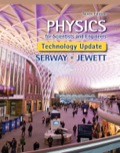
(a)
The magnitude of the relative acceleration as a function of
(a)
Answer to Problem 13.76AP
The magnitude of the relative acceleration as a function of
Explanation of Solution
A object of mass

Figure I
Formula to calculate the relative acceleration is,
Here,
Formula to calculate the gravitational force exerted by the object on the Earth is,
Here,
By Newton’s law the force exerted by the object is,
From equation (II) and equation (III) is,
The forces
Here,
Substitute
By Newton’s law the force exerted by the Earth is,
From equation (IV) and equation (V) is,
Substitute
Substitute
Conclusion:
Therefore, the magnitude of the relative acceleration as a function of
(b)
The magnitude of the relative acceleration for
(b)
Answer to Problem 13.76AP
The magnitude of the relative acceleration for
Explanation of Solution
From equation (VI) the relative acceleration is,
Substitute
Conclusion:
Therefore, the magnitude of the relative acceleration for
(c)
The magnitude of the relative acceleration for
(c)
Answer to Problem 13.76AP
The magnitude of the relative acceleration for
Explanation of Solution
From equation (VI) the relative acceleration is,
Substitute
Conclusion:
Therefore, the magnitude of the relative acceleration for
(d)
The magnitude of the relative acceleration for
(d)
Answer to Problem 13.76AP
The magnitude of the relative acceleration for
Explanation of Solution
From equation (VI) the relative acceleration is,
Substitute
Conclusion:
Therefore, the magnitude of the relative acceleration for
(e)
The pattern of variation of relative acceleration with
(e)
Answer to Problem 13.76AP
The relative acceleration is directly proportional to the mass
Explanation of Solution
From equation (VI) the relative acceleration is,
This is the linear equation and shows the relative acceleration is directly proportional to the object having mass
Conclusion:
Therefore, the relative acceleration is directly proportional to the object having mass
Want to see more full solutions like this?
Chapter 13 Solutions
EBK PHYSICS FOR SCIENTISTS AND ENGINEER
- 20. Two small conducting spheres are placed on top of insulating pads. The 3.7 × 10-10 C sphere is fixed whie the 3.0 × 107 C sphere, initially at rest, is free to move. The mass of each sphere is 0.09 kg. If the spheres are initially 0.10 m apart, how fast will the sphere be moving when they are 1.5 m apart?arrow_forwardpls help on allarrow_forwardpls help on thesearrow_forward
- pls help on all asked questions kindlyarrow_forwardpls help on all asked questions kindlyarrow_forward19. Mount Everest, Earth's highest mountain above sea level, has a peak of 8849 m above sea level. Assume that sea level defines the height of Earth's surface. (re = 6.38 × 106 m, ME = 5.98 × 1024 kg, G = 6.67 × 10 -11 Nm²/kg²) a. Calculate the strength of Earth's gravitational field at a point at the peak of Mount Everest. b. What is the ratio of the strength of Earth's gravitational field at a point 644416m below the surface of the Earth to a point at the top of Mount Everest? C. A tourist watching the sunrise on top of Mount Everest observes a satellite orbiting Earth at an altitude 3580 km above his position. Determine the speed of the satellite.arrow_forward
- pls help on allarrow_forwardpls help on allarrow_forward6. As the distance between two charges decreases, the magnitude of the electric potential energy of the two-charge system: a) Always increases b) Always decreases c) Increases if the charges have the same sign, decreases if they have the opposite signs d) Increases if the charges have the opposite sign, decreases if they have the same sign 7. To analyze the motion of an elastic collision between two charged particles we use conservation of & a) Energy, Velocity b) Momentum, Force c) Mass, Momentum d) Energy, Momentum e) Kinetic Energy, Potential Energyarrow_forward
 Principles of Physics: A Calculus-Based TextPhysicsISBN:9781133104261Author:Raymond A. Serway, John W. JewettPublisher:Cengage Learning
Principles of Physics: A Calculus-Based TextPhysicsISBN:9781133104261Author:Raymond A. Serway, John W. JewettPublisher:Cengage Learning Glencoe Physics: Principles and Problems, Student...PhysicsISBN:9780078807213Author:Paul W. ZitzewitzPublisher:Glencoe/McGraw-Hill
Glencoe Physics: Principles and Problems, Student...PhysicsISBN:9780078807213Author:Paul W. ZitzewitzPublisher:Glencoe/McGraw-Hill Classical Dynamics of Particles and SystemsPhysicsISBN:9780534408961Author:Stephen T. Thornton, Jerry B. MarionPublisher:Cengage Learning
Classical Dynamics of Particles and SystemsPhysicsISBN:9780534408961Author:Stephen T. Thornton, Jerry B. MarionPublisher:Cengage Learning University Physics Volume 1PhysicsISBN:9781938168277Author:William Moebs, Samuel J. Ling, Jeff SannyPublisher:OpenStax - Rice University
University Physics Volume 1PhysicsISBN:9781938168277Author:William Moebs, Samuel J. Ling, Jeff SannyPublisher:OpenStax - Rice University Physics for Scientists and Engineers: Foundations...PhysicsISBN:9781133939146Author:Katz, Debora M.Publisher:Cengage Learning
Physics for Scientists and Engineers: Foundations...PhysicsISBN:9781133939146Author:Katz, Debora M.Publisher:Cengage Learning Modern PhysicsPhysicsISBN:9781111794378Author:Raymond A. Serway, Clement J. Moses, Curt A. MoyerPublisher:Cengage Learning
Modern PhysicsPhysicsISBN:9781111794378Author:Raymond A. Serway, Clement J. Moses, Curt A. MoyerPublisher:Cengage Learning





